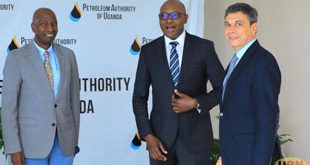
What key areas does your work portfolio focus on?
When the Telecom duopoly was de-regularised in 2006, we were the first company to get a licence. We started the business as wholesalers of voice and data under the capacity re-sell licence. We spent the first three years doing only that.
We then rolled into the retail market when the submarine cables landed in Mombasa from which we got access. We laid our first fiber cable in town to enable our business and in the process we discovered that people didn’t have enough fiber in Kampala. We decided to lay a fiber in people’s offices and as you expect, competition followed. We then went to smaller enterprises where no service provider was interested and this gave a whole new direction for telecoms.
What are the key elements in your management philosophy as a manager?
Management is about people as a resource; understanding them, knowing their skills set and capabilities and how to have the right team players for the job.
Over the years, I have worked with teams and discovered that it is about understanding the team and helping them understand the clients.
It is a wrong approach for a manager to expect treatment like a king. Relating with the team creates a feel of comfort and helps people share freely and in the process, the manager is able to guide them deliver results.
What is your assessment of internet service and data usage in Uganda?
The market always wants internet at a lower price, faster speeds, and better services. There has been a major evolution in the industry over the past decade, and customers have become more cautious and don’t just need a connection but a reliable one. Clients nowadays have internet-enabled devices at home like TV, phones, computer, play station among others and want to do business anywhere.
Your company has not included dongles and MyFi? What explains the delayed move?
The cost of investment and sustaining it explains the delay. If we are to go into that area, we need to pay licensed spectrum from the Uganda Communications Commission (UCC), set up base stations all over the place which requires an investment of $10 to $15million to do all that.
We decided to rather do fixed services and offer the customers right from where they are situated. However we have been in talks with other telecoms about doing a mobile virtue network so we can ride over their network but we are still looking at the mathematics involved.
What challenges have held back your business operations in Uganda?
It has not been a smooth path for an indigenous company. There is stiff competition. For instance, we laid a fiber cable from Kampala to the Tanzanian border which investment cost us about $1million and shortly after that, government laid another cable along the same path which diluted our investment.
Internet penetration in Uganda remains low. What explains the low levels?
It is not just internet but infrastructure in general. Internet rides on infrastructure. For instance, if there are high voltage power lines everywhere, we can get internet connections there because they have a fiber link on them that we can utilise to build in the metros when we get upcountry.
But also, as compared to the population, mobile penetration remains very low. The numbers that are even declared by the telecoms are not really active users because there are people with dormant Sim cards. If it was, then internet penetration would be higher since it also works on mobile phones. So, low internet usage in Uganda is part of the whole big picture of infrastructure not being deep to the grassroots.
What initiatives have you put in place to broaden the reach of internet access across all market segments?
We make sure that all regions are connected to this revolution. For instance, we built a fiber in Mbarara, Masaka, Jinja, Mbale, Soroti, Lira, and we are getting into Fort Portal, Gulu, Arua so that people in these areas can share the same experience.
We have also started looking into initiatives that are very niche. For instance, we are in talks with the United Nations Children’s Fund (UNICEF) and the United States Agency for International Development (USAID) about extending rural connectivity.
Refugee camps have a strong need for connectivity because they need to communicate to their people back home. Their biggest problem is repatriation and they can know their fate through internet connections.
Uganda has the biggest number of refugees in Africa so it is an area worth considering investing in to increase penetration. We are looking at working with these bodies to create connectivity in refugee camps.
You have been in the market for the last ten years. What premier achievements have you registered?
For starters, staying around for ten years is just not easy. We have maintained relevance in the telecom space and expanded our services into other countries like Zambia and DRC. We have also got licenses in many other countries but plan to enter those markets at the right time.
How can internet service providers tap into opportunities that come with regional blocs like East African Community?
Our network spreads across the whole of east Africa because we have strategic partners in all these countries. We spread our networks into locations that are strategically important across the region.
Where does the future of your operations lie in Uganda?
The ultimate aim for us is to have fibre into people’s homes rather than offices. We want to be able to drop one cable and deliver all the services like video, voice and internet which is triple play services to our clients. For this, we are already in talks with Star Times and DSTV to be strategically positioned to get into homes.
****
editor@independent.co.ug
 The Independent Uganda: You get the Truth we Pay the Price
The Independent Uganda: You get the Truth we Pay the Price


